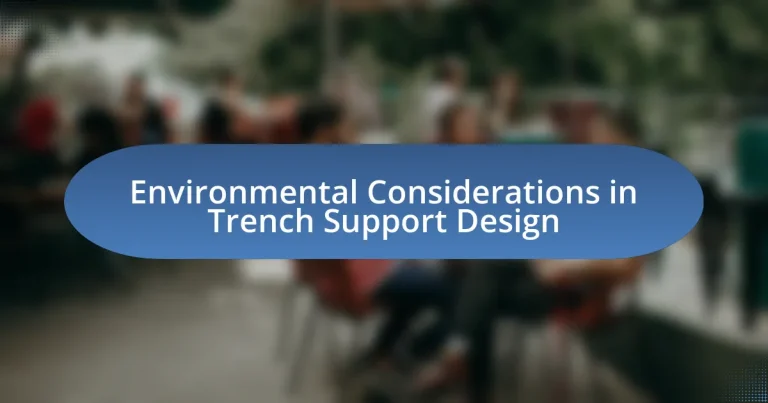The article focuses on the environmental considerations in trench support design, emphasizing the importance of soil stability, groundwater management, and ecological impact. It outlines how different soil conditions affect trench safety and the necessity of managing groundwater to prevent collapses. The article also discusses the role of vegetation in enhancing soil stability and strategies to minimize environmental disruption during trenching activities. Furthermore, it highlights key regulations governing trench support design and best practices for ensuring compliance and sustainability in construction projects.

What are the key environmental considerations in trench support design?
Key environmental considerations in trench support design include soil stability, groundwater management, and ecological impact. Soil stability is crucial as it affects the trench’s structural integrity; unstable soils can lead to collapses, posing risks to workers and the environment. Groundwater management is essential to prevent flooding and erosion, which can disrupt local ecosystems and contaminate water sources. Additionally, minimizing ecological impact involves assessing the surrounding flora and fauna, ensuring that construction activities do not harm habitats or biodiversity. These considerations are supported by guidelines from organizations such as OSHA and the EPA, which emphasize the importance of environmental protection in construction practices.
How do soil conditions impact trench support design?
Soil conditions significantly impact trench support design by influencing the stability and safety of excavations. Different soil types, such as clay, sand, or silt, exhibit varying properties like cohesion, friction angle, and moisture content, which directly affect the lateral earth pressures acting on trench walls. For instance, cohesive soils can provide better support due to their ability to stick together, while granular soils may require additional support systems like shoring or bracing to prevent collapse. According to the Occupational Safety and Health Administration (OSHA), trench walls must be designed to withstand the forces exerted by the surrounding soil, which can vary dramatically based on soil conditions, leading to specific design requirements for safety and structural integrity.
What types of soil are most challenging for trench support?
Cohesive soils, such as clay, and loose, granular soils, like sand, are the most challenging for trench support. Cohesive soils can retain water and become unstable when saturated, leading to potential collapse. Loose granular soils, on the other hand, lack cohesion and can shift easily, increasing the risk of trench failure. According to the Occupational Safety and Health Administration (OSHA), trenches in these soil types require specific support systems to mitigate hazards, emphasizing the need for proper engineering solutions in trench support design.
How does soil moisture affect trench stability?
Soil moisture significantly affects trench stability by influencing the soil’s cohesion and friction angle. When soil moisture levels are high, the increased water content can lead to reduced soil strength, making the trench walls more susceptible to collapse. For instance, saturated soils can lose their ability to support weight due to pore water pressure, which can destabilize the trench. Research indicates that a moisture content exceeding the soil’s plastic limit can result in a dramatic decrease in shear strength, thereby increasing the risk of trench failure.
Why is groundwater management important in trench support?
Groundwater management is crucial in trench support because it prevents soil instability and potential collapse during excavation. When groundwater levels are not properly managed, excessive water can lead to increased pore pressure in the soil, reducing its effective stress and compromising the structural integrity of trench walls. Studies have shown that improper groundwater control can result in trench failures, which pose safety risks and can lead to costly project delays. For instance, the Occupational Safety and Health Administration (OSHA) emphasizes the importance of managing groundwater to ensure safe working conditions in excavation sites.
What methods are used to control groundwater in trenching projects?
Methods used to control groundwater in trenching projects include dewatering, trench boxes, and groundwater cutoff walls. Dewatering involves the removal of water from the trench area, typically using pumps or well points to lower the water table and maintain dry working conditions. Trench boxes provide a protective structure that can help manage water inflow while allowing for safe excavation. Groundwater cutoff walls, often made of impermeable materials, are installed to prevent water from entering the trench, effectively isolating the work area from surrounding groundwater. These methods are essential for ensuring safety and stability during trenching operations.
How does groundwater influence the choice of support systems?
Groundwater significantly influences the choice of support systems in trench design by affecting soil stability and the risk of collapse. When groundwater levels are high, the soil becomes saturated, reducing its cohesion and increasing the likelihood of failure. This necessitates the use of more robust support systems, such as sheet piling or bracing, to counteract the hydrostatic pressure and maintain structural integrity. Studies have shown that in areas with high groundwater, the use of traditional support systems may lead to increased safety risks and project delays, thus requiring engineers to adapt their designs accordingly to ensure safety and compliance with regulations.
What role does vegetation play in trench support design?
Vegetation plays a critical role in trench support design by enhancing soil stability and reducing erosion. The root systems of plants help bind soil particles together, which can prevent collapse during excavation. Studies have shown that areas with dense vegetation experience lower rates of soil erosion and increased soil cohesion, which are essential factors in maintaining trench integrity. Additionally, vegetation can absorb excess water, reducing hydrostatic pressure on trench walls, further contributing to the overall stability of the trench.
How can vegetation affect soil erosion around trenches?
Vegetation significantly reduces soil erosion around trenches by stabilizing the soil with root systems. The roots of plants bind soil particles together, which decreases the likelihood of soil displacement during rainfall or wind events. Additionally, vegetation intercepts rainfall, reducing the impact of raindrops on the soil surface and minimizing runoff. Studies have shown that areas with dense vegetation can experience up to 80% less erosion compared to bare soil, highlighting the effectiveness of plant cover in protecting soil integrity around excavated areas.
What strategies can be employed to minimize vegetation impact?
To minimize vegetation impact, strategies such as implementing erosion control measures, using biodegradable materials, and scheduling construction activities outside of critical growth periods can be employed. Erosion control measures, like silt fences and sediment basins, prevent soil displacement and protect root systems. Biodegradable materials reduce long-term environmental effects, as they decompose and integrate back into the ecosystem. Scheduling construction outside of critical growth periods, typically during the dormant season for many plants, minimizes disruption to vegetation and allows for natural recovery. These strategies are supported by studies indicating that proactive planning and material selection significantly reduce ecological disturbances during construction activities.

How do regulations influence environmental considerations in trench support design?
Regulations significantly influence environmental considerations in trench support design by mandating compliance with safety and environmental protection standards. These regulations, such as the National Environmental Policy Act (NEPA) in the United States, require assessments of potential environmental impacts before construction begins. For instance, regulations may dictate the use of specific materials that minimize soil erosion and protect local ecosystems, ensuring that trench designs do not adversely affect surrounding habitats. Additionally, compliance with regulations often necessitates the implementation of best management practices (BMPs) to control runoff and sedimentation, thereby safeguarding water quality during excavation activities.
What are the key regulations governing trench support design?
The key regulations governing trench support design include the Occupational Safety and Health Administration (OSHA) standards, specifically 29 CFR 1926 Subpart P, which outlines requirements for excavation and trenching safety. These regulations mandate that employers provide adequate support systems to prevent collapses, such as trench boxes or shoring, based on soil type and depth. Additionally, the American National Standards Institute (ANSI) provides guidelines through ANSI A10.12, which emphasizes the importance of proper design and installation of trench support systems to ensure worker safety. Compliance with these regulations is critical to minimize risks associated with trenching operations, as evidenced by OSHA’s statistics indicating that trench collapses account for a significant number of fatalities in construction.
How do local environmental laws affect trenching practices?
Local environmental laws significantly influence trenching practices by imposing regulations that ensure the protection of ecosystems and natural resources. These laws often require assessments of potential environmental impacts before trenching activities commence, mandating compliance with standards for soil erosion control, water quality protection, and habitat preservation. For instance, the Clean Water Act in the United States necessitates permits for activities that may discharge pollutants into water bodies, directly affecting how trenching is conducted near such areas. Additionally, local laws may dictate specific methods and materials to minimize environmental disruption, thereby shaping the techniques and equipment used in trenching operations.
What are the consequences of non-compliance with environmental regulations?
Non-compliance with environmental regulations can lead to significant legal, financial, and reputational consequences for organizations. Legal repercussions often include fines, penalties, and potential litigation, as regulatory bodies enforce compliance through strict penalties; for instance, the Environmental Protection Agency (EPA) can impose fines that reach up to $37,500 per day for violations of the Clean Water Act. Financially, companies may face increased operational costs due to remediation efforts, loss of permits, or the need to implement costly compliance measures after the fact. Additionally, reputational damage can result in loss of customer trust and market share, as stakeholders increasingly prioritize environmental responsibility. These consequences underscore the importance of adhering to environmental regulations in trench support design and other construction practices.
How can designers ensure compliance with environmental standards?
Designers can ensure compliance with environmental standards by integrating sustainable materials and practices into their design processes. This involves selecting eco-friendly materials that meet regulatory requirements, conducting environmental impact assessments, and adhering to local and international environmental regulations such as ISO 14001. For instance, using recycled materials can significantly reduce the carbon footprint of a project, while regular audits can help verify compliance with established environmental standards.
What best practices should be followed to meet regulatory requirements?
To meet regulatory requirements in trench support design, it is essential to conduct thorough site assessments and adhere to local, state, and federal regulations. Site assessments should evaluate soil conditions, groundwater levels, and potential environmental impacts, ensuring compliance with standards such as OSHA regulations and local building codes. Additionally, implementing best practices like using environmentally friendly materials, maintaining proper drainage, and ensuring worker safety through training and protective equipment further align with regulatory expectations. These practices are supported by guidelines from organizations such as the American Society of Civil Engineers, which emphasizes the importance of safety and environmental stewardship in construction projects.
How can environmental assessments be integrated into the design process?
Environmental assessments can be integrated into the design process by incorporating them as a fundamental step in the project development timeline. This integration involves conducting assessments early in the design phase to identify potential environmental impacts, allowing for informed decision-making and design modifications that minimize negative effects. For instance, utilizing tools such as Environmental Impact Assessments (EIAs) ensures that designers evaluate factors like soil stability, water quality, and biodiversity before finalizing designs. Research indicates that projects that incorporate environmental assessments from the outset can reduce costs and project delays by addressing potential issues proactively, as demonstrated in case studies where early assessments led to significant design alterations that enhanced environmental sustainability.

What are the best practices for minimizing environmental impact in trench support design?
The best practices for minimizing environmental impact in trench support design include using sustainable materials, implementing effective erosion control measures, and optimizing excavation techniques. Sustainable materials, such as recycled steel or biodegradable supports, reduce resource depletion and waste. Effective erosion control measures, like silt fences and sediment basins, prevent soil erosion and protect water quality. Optimizing excavation techniques, such as minimizing trench width and depth, reduces the disturbance of surrounding ecosystems. These practices collectively contribute to lower environmental footprints and compliance with regulations aimed at protecting natural resources.
How can trench support design be optimized for sustainability?
Trench support design can be optimized for sustainability by utilizing materials that are both durable and recyclable, such as steel and engineered wood. These materials reduce the environmental impact by minimizing waste and allowing for reuse in future projects. Additionally, implementing modular designs can enhance efficiency, as they allow for quicker assembly and disassembly, reducing energy consumption during construction. Research indicates that using advanced modeling techniques, such as Building Information Modeling (BIM), can further optimize trench support systems by predicting performance and minimizing resource use, leading to a more sustainable approach in construction practices.
What materials are considered environmentally friendly for trench support?
Environmentally friendly materials for trench support include biodegradable composites, recycled steel, and engineered wood products. Biodegradable composites, made from natural fibers and resins, decompose without harming the environment. Recycled steel reduces the need for new raw materials and minimizes energy consumption during production. Engineered wood products, such as laminated veneer lumber, utilize sustainably sourced timber and have a lower carbon footprint compared to traditional materials. These materials contribute to sustainable construction practices by reducing waste and promoting resource efficiency.
How can the design process incorporate sustainable practices?
The design process can incorporate sustainable practices by prioritizing the use of eco-friendly materials and minimizing waste throughout the project lifecycle. For instance, selecting recycled or renewable materials reduces the environmental impact associated with resource extraction and manufacturing. Additionally, implementing design strategies that optimize energy efficiency, such as passive solar design or efficient insulation, can significantly lower energy consumption during the use phase. Research indicates that buildings designed with sustainability in mind can reduce energy use by up to 50% compared to conventional designs, as highlighted in the “Sustainable Building Design: A Comprehensive Guide” by Smith and Johnson. This approach not only benefits the environment but also enhances the long-term viability and cost-effectiveness of the design.
What techniques can be used to reduce soil disturbance during trenching?
Techniques to reduce soil disturbance during trenching include using narrow trenching methods, employing trenchless technology, and implementing careful excavation practices. Narrow trenching minimizes the width of the excavation, thereby preserving more surrounding soil structure. Trenchless technology, such as horizontal directional drilling, allows for the installation of utilities without extensive surface disruption. Additionally, careful excavation practices, such as using hand tools in sensitive areas and maintaining soil moisture, help to minimize compaction and disturbance. These methods collectively contribute to maintaining soil integrity and reducing environmental impact during trenching activities.
How does the timing of trenching activities affect environmental impact?
The timing of trenching activities significantly affects environmental impact by influencing soil erosion, habitat disruption, and water quality. Conducting trenching during wet seasons can exacerbate soil erosion and sediment runoff into nearby water bodies, leading to increased turbidity and potential harm to aquatic ecosystems. Conversely, trenching during dry seasons can minimize these risks, as the soil is less likely to be saturated and more stable. Research indicates that seasonal timing can reduce the disturbance to wildlife, particularly during breeding seasons, thereby preserving biodiversity. For instance, a study by the U.S. Environmental Protection Agency highlights that avoiding trenching during critical wildlife periods can mitigate negative ecological consequences.
What role does technology play in minimizing environmental disruption?
Technology plays a crucial role in minimizing environmental disruption by enabling more efficient resource management and reducing waste. Advanced technologies such as Geographic Information Systems (GIS) and Building Information Modeling (BIM) allow for precise planning and execution of trench support designs, which helps to limit land disturbance and protect surrounding ecosystems. For instance, the use of trenchless technology, which involves minimal excavation, significantly reduces soil erosion and habitat destruction compared to traditional methods. Additionally, innovations in materials, such as eco-friendly composites, contribute to sustainability by decreasing the carbon footprint associated with construction activities. These technological advancements collectively enhance environmental protection efforts in infrastructure projects.
What are practical tips for effective trench support design?
Effective trench support design requires the implementation of several practical tips to ensure safety and stability. First, assess soil conditions thoroughly, as different soil types influence the choice of support systems; for instance, cohesive soils may require different support than granular soils. Second, utilize appropriate shoring methods, such as hydraulic or trench boxes, to prevent collapses, which can occur in trenches deeper than five feet according to OSHA regulations. Third, ensure proper drainage to mitigate water accumulation, as excess water can weaken soil and increase the risk of trench failure. Fourth, regularly inspect trench walls for signs of distress or movement, as early detection can prevent accidents. Lastly, train workers on safety protocols and the importance of adhering to design specifications, as human error is a significant factor in trench-related incidents. These tips are grounded in industry standards and regulations, emphasizing the importance of safety in trench support design.


